When Nintendo Power introduced Epic Center to its pages in 1995, it offered previews and tips for many role-playing games on Nintendo platforms as the genre was growing in popularity. A feature I loved in gaming mags at this time were when games from overseas were previewed, and Epic Center would eventually do this with RPGS exclusively for the Super Famicom. In these parts at-home Internet was still finding its footing. When you’re a kid who doesn’t have much savvy because they’re still new to the Internet and you’re living in a community without an import scene – that you could possibly be aware of anyhow – information like this just seemed extra special.
Among the games showcased in issue 74 of Nintendo Power was the unfortunately named Lady Stalker. I was interested in all of the Super Famicom games shown in this issue but Lady Stalker stood out. It was an isometric view like Equinox, another game I poured over in the pages of NP, or Mystic Towers – a game I fell in love with through shareware. It was an action RPG that promised to be engaging and quirky. And while I would eventually play Landstalker and place it among my favourite Genesis games, somehow I’ve held out this long for Lady Stalker.


Lady Stalker is then a spinoff of Landstalker. In Landstalker you played as the treasure hunter ‘Nigel the Landstalker’ per the box to find the treasures of King Nole or to ‘stalk a King’s ransom.’ In Lady Stalker you play as a treasure hunter or ‘stalker’ named Lady, it’s really that benign.
In the introductory scenes Lady reads about a great treasure in Death Land and means to abandon her studies to seek it out. But Death Land isn’t as accommodating as it sounds, and she will face many trials before finally unraveling its secrets.
Movement and Exploration
I’ve spent some time establishing a relationship between Lady Stalker and Landstalker to this point, but in truth they’re very different games. Landstalker had platforming as a core element and used its lack of drop shadow to devious ends with perspective tricks. There are plenty of perspective tricks in Lady Stalker, but Lady generally can’t jump.
Instead, you can move vertically over certain elevations of ground acting as steps. The lack of a standard jump doesn’t really hinder Lady Stalker in the least since it’s not built with it in mind. Lady can instead pick up blocks to create staircase. Or she can run accelerating into some pretty fast movement. Run fast enough and Lady can skip over one block gaps, or break through cracked walls and certain objects. What results is a mix of logic puzzles, perspective puzzles, and combat that continually feel fresh.
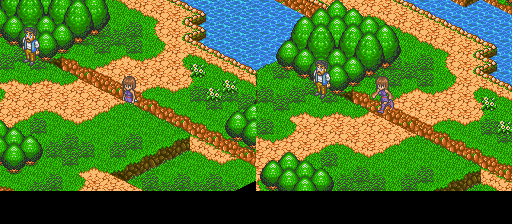
For instance, Lady Stalker features a sewer dungeon – there’s no surprise there. But using the same actions you had been using to pick up blocks you use to reconfigure pipes to drain an area in which you need to progress. You then fight against currents to make it safely around debris. You then struggle to keep your breath as you try to navigate otherwise simple movement underwater. But it all has this forward momentum such that even when the game leans into a trope like this it stays fresh and engaging.
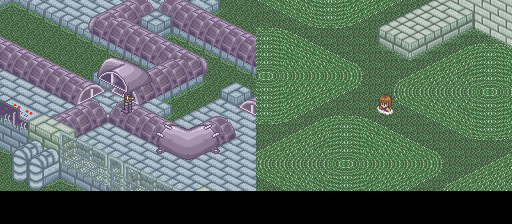
Lady Stalker is rife with treasure and interesting things to see. The game has some genuinely pretty locations as it progresses, and you always wonder what was on that other path. For instance when the game plops Lady in a minecart she still has some control over its movement but you will likely see some loot that you passed by. Was it a different turn you had to take? Or were you meant to backtrack as soon as the cart crashed? You can find items, weapons, and even special currency for one specific shop so it’s always worth looking into as many possibilities as you can.
As far as perspective tricks are concerned, they’re definitely here. Sometimes you need to navigate without seeing Lady, sometimes you go into the dark spaces behind the map. But there’s nothing on the level of Landstalker’s notorious Green Maze, for instance. In fact there are many clear, open corridors in Lady Stalker to accommodate its random encounters. They’re in the same series but they definitely have a different focus.

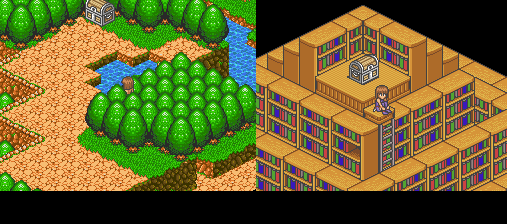
Combat and the Action RPG
Random encounters might have raised some eyebrows, and I will concede that the encounter rate in Lady Stalker can at times be quite high. In fact, I would say that the rooms in this game that are multiple passageways snaking around each other are explicitly designed to make Lady encounter as many monsters as possible. However, in rooms that are heavily puzzle themed the encounter rate is often nil, you won’t fight anything. Even within the same room, certain areas seem designated to fight while others are kept clear. This is a welcome consideration.
Battles take place directly on the map you encounter them. The encounter has an invisible perimeter but you can otherwise move around the map as you were. Lady can move and reposition and attack. As she gains levels she will gain special attacks which differ depending on her weapon. Once she learns special attacks she can charge a meter to execute a powerful special move. As you gain more special moves, the attack you use depends on how far you’ve charged the meter. Lady can equip Boots for stronger, close ranged attacks or the weaker Whips for the ability to hit enemies without being directly next to them.
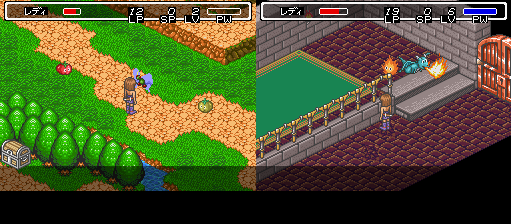

Lady will eventually find the two characters from the intro scenes. The elderly gardener Yoshio specializes in elemental spells but eventually learns utility magic such as the ability to teleport to visited towns or a spell that allows the party to move about without taking environmental damage. The chef Cocks (in the manual, Cooks in some other media) is the party’s healer and he will be a real workhorse. While you are exploring dungeons and the overworld, Lady will be by herself. Yoshio and Cocks will join when she enters a battle, or during certain story or town scenes.
While Lady is still by herself, enemies are generally pretty easy. There are combinations or contenders that can bring some hurt but generally keeping a decent stock of medicine will see you through. When Yoshio and Cocks join, enemies start to become more capable. The combat doesn’t gets frustrating, however, if you’re keeping up with gear and levels. You can command certain spells from your ally, interrupt enemies with Lady’s superior attacks and get through encounters pretty quickly.
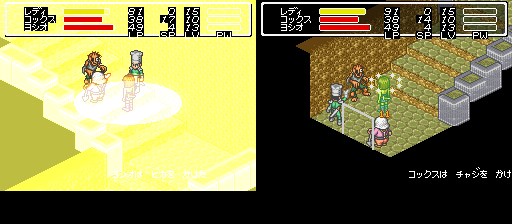
Grinding is not really necessary if you’re fighting enemies as you encounter them, and gear is usually a decent jump in attack or defense. Gear is bought through shops or found in dungeons, and you generally get enough cash through the game that you can afford some upgrades as they become available. Certain weapons later in the game can cast spells when used as items in battle, so be sure to hold onto those.
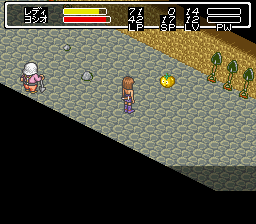
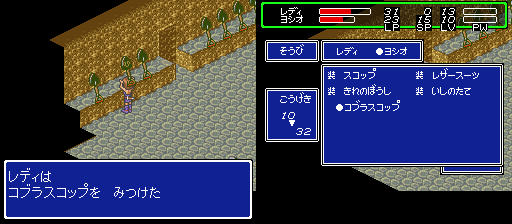
Flavour and Importability
Lady Stalker is relatively heavy on text so there might be concerns about playing the game with a language barrier and – yes – there are situations where this comes into play. As you play through Lady Stalker, characters move to and from locations or you find key items to influence aspects of other areas. There’s actually a lot of backtracking in the game which in itself is made easy through items and spells, but you need to know when backtracking is appropriate. One puzzle that immediately jumps to mind is when you need to organize a story for a Babybaron monster by checking eight bookcases in a specific sequence.
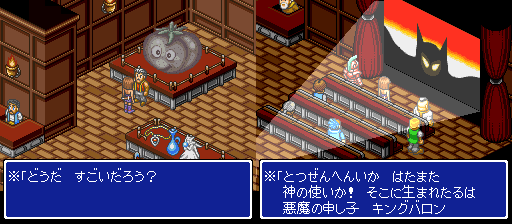

There are resources available for Lady Stalker or you could try machine translation but I’m sure a lot of context and flavour would be lost in said translation. On the upside, most of the puzzles are easy to figure out as you go. Most key items are used in the same dungeon you find them, and the movement and combat challenges are very natural.
Lady Stalker is also dripping with flavour, and this is accomplished through more than just the text. There is a lot of visual storytelling in this game. Iconography shows you what the dominant monsters on Death Land Island are. You get clear demonstrations of how the humans here treat the island as a theme park, but as you progress and populations change you see the darker undertones of the island and the evil influence of the mysterious Baron. Death Land isn’t all fun and games, huh.
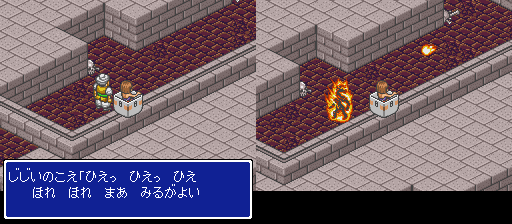

The game is clearly very cheeky and I hope a full translation is completed at some point, as of writing this I couldn’t find one but I could be mistaken. As much as I loved this game, I think the experience is yet to be complete in that respect.
Lady Stalker is a colourful game with a lovely use of its isometry. I don’t want to spoil some of the later locales through screenshots but some of the things the game did with transparency, geometry, height, and perspective were really quite solid. Sprites are generally smaller to accomodate the perspective and menus but they all have great animation and personality.

Wrapping it Up
There aren’t many games in the Stalker series, and with Landstalker being such a stellar classic for the Genesis it’s easy to wish that Lady Stalker were a direct sequel rather than a spinoff. I certainly would have taken another game with the same mechanics – I liked Landstalker that much. But sometimes the best result is to mix things up.
Lady Stalker obtains its own identity both through presentation and execution. By using similar perspective tricks and isometric traversal without jumping, and leaning more heavily into its RPG elements it comes together as something special all on its own. Anyone who enjoyed Landstalker owes it to themselves to try Lady Stalker. Yes – it’s different, but whether you end up liking it or not it’s definitely worth that chance.
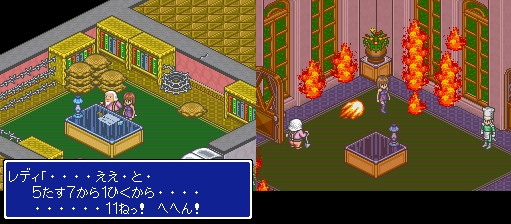
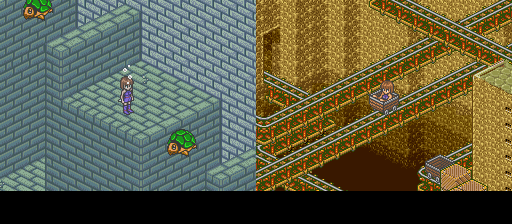
I’m not sure why it took me so long to play a game I’ve coveted for so long. I’ve always preferred to have a physical copy in hand for when I play something that has that particular quality, but that’s not always realistic. Nevertheless, I’m glad that it’s held up to that long held interest. There’s something to be said for finally trying games you’ve had in the back of your mind since you read about them as a kid. There’s been a few like that.
For people looking for an Action RPG on the Super Famicom this one isn’t too long of a commitment, it’s very clever, and might need a bit of help for context or text puzzles. Lady Stalker is fast paced with constant momentum without feeling rushed, full of flavour and creative use of its perspective without being overbearing. You will know very quickly whether it’s for you or not, but this game deserves more hands on deck.
Nintendo Power has many issues archived on Archive.org, Issue 74’s Epic Center has the small look at Lady Stalker.


Well, congrats on finishing a game you’ve long coveted!
It is a bit surprising this still hasn’t been translated yet in English. I could never get into Landstalker, but I understand why people like it.
Is it shorter in length or around the same as Landstalker? Landstalker seemed like a fairly long game.
Cocks is probably the best character name ever, lol.
I really think it was meant to be Cooks but Cocks is a better name yeah, ha ha.
There have been projects to translate it but they’re either dropped or on hold. There’s enough text in this game that while machine translation could help, you’re still losing something. I think it’s a matter of demand, not sure how many people are lining up for Lady Stalker.
I think my final time was 11 or 12 hours trying to be thorough. Playing after to get screenshots was a lot faster getting to the point of recruiting the party. It’s much more straightforward in geography than LandStalker but like I wrote there’s some backtracking that might not be readily apparent.
It’s been a long time since my last play of Landstalker at this point, so I kinda forget how long it takes. It had a bit of meat to it though.
That’s what I was thinking as well.
Yeah, long on hold. Demand can influences choice, but in the case of fan translations, I don’t think it comes into play most of the time.
I see. I was just going by a walkthrough. After after the forest maze part, I think that was still only around 35% done. So it seemed like a fairly long game to me.
Yeah, Landstalker seems to surprise people because they aren’t expecting a platformer heavy game to be as long as that. Another factor with that one is that you will be retrying rooms more because it relies on perspective tricks much more heavily than Lady Stalker. And towards the end that can admittedly get punishing. I’d say you beat the most notorious section (Green Maze) but there are more isolated puzzles like climbing a tower that can do the same things.
Lady Stalker isn’t quite as punishing, it’s more about random encounter rate in that one sometimes – though you can run, or if there’s a door on screen just leave to the next room. Where this can cause issues is when you’re climbing something and you enter an encounter that prevents you from advancing further (battles partition the room) so you drop down to fight. I didn’t really try running from battles towards the second half of the game, I don’t know how difficult that gets. Story flags are generally the most confusing and only then because of the language barrier.
I think with Lady Stalker it’s worth a try for people who liked Landstalker and for people who didn’t like Landstalker. Because it provides an isometric action RPG with a fun world to run around in but it does things quite differently the more you think about it. It’s part of why I’d love a translation to reach completion so I can in better confidence recommend it to more people.
True. The areas in Landstalker seem to take longer than most games, which adds to the length. Yeah, I was really not liking the Green Maze part that much, lol. Though even the areas before, it was just kind of meh for me. Maybe it’d be a bit better with an actual controller.
Yeah, it does seem to trend a good line of familiarity and difference that I can see how you could still recommend it for those that didn’t like Landstalker. Out of the question for most without a translation though.
Landstalker is on switch online now. The analog stick works pretty good inplace of the sega genesis d-pad. Also the rewind feature is a game changer. Missed a jump? Rewind! Accidentally went the wrong way? Rewind!